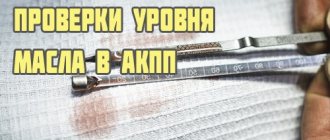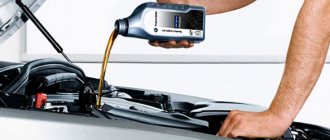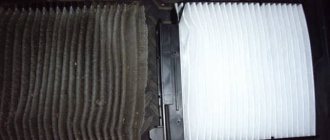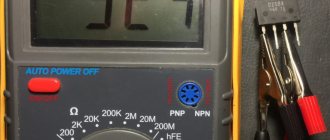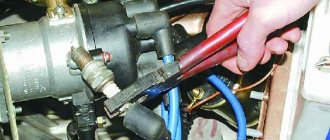18.07.2019
| (Votes: 1, Rating: 1) |
Issues discussed in the material:
- How are current consumers connected to the vehicle's on-board system?
- What can cause current leakage in a car?
- How to detect a current leak in a car yourself
- How to eliminate current leaks in a car
- What are the dangers of current leaks in a car?
In the evening you left the car with a charged battery, but the next day you discovered that it was dead. What could be the problem? How to check for current leakage in a car? Is it possible to eliminate a possible breakdown? Let's figure it out.
The principle of connecting current consumers to the on-board network
Electric current will flow through the conductor only if the electrical circuit is closed. Electricity consumption should be normal - battery terminal “plus” - consumer - terminal “minus”, and the circuit should not be broken. As an example, we gave the simplest scheme. In your car, consumers are connected to a circuit whose complexity is several times higher. Therefore, it will be difficult for a non-professional auto electrician to understand all the nuances.
How to check for current leakage in a car? Refer to the image above. On it you can see that there is a single “minus” between the lamp and terminal 85 of the relay; it is usually connected to ground (body).
In this case, a switch is installed on the positive wire, breaking the circuit. When the switch contacts close, electricity flows through the relay coil, which is connected to pins 85 and 86. Due to the electromagnetic field, the coil begins to close the 87th and 30th contacts, and the electric current flows through the lamps.
The described scheme is standard for most vehicles. However, usually the circuit is opened by an additional switch - the ignition switch, and the fuse is embedded in the positive wire. To make it more convenient, one or two mounting blocks combine relays with fuses. Knowing this, you won't be shocked when you see a lot of wiring harnesses. You can also, by dividing a huge number of connected circuits into mini-circuits, check for current leakage in a car using clamps.
Some car devices are combined into common networks. Imagine that this is one consumer, but simply expanded in space. Is a current leak detected in the car after checking? The reason is that different circuits are connected to each other or to the “ground” of the machine due to the fact that the wiring insulation has become unusable. Leakage can also occur due to electric current “bridges” that appear due to dirt.
We recommend
“Checking the brake fluid: a guarantee of road safety” Read more
Lada 2114 Graphite metallic › Logbook › The leak has finally leaked. From 300 mA to 40 mA.
After reading forums and watching videos from various auto electricians, I began to take out all the fuses in the mounting block one by one and look at the change in leakage.
Then I got to the alarm and its fuses - the leak changed very slightly, by about 30 mA. In general, for a long time I looked for the cause, I thought it was a short circuit in the wiring to the body or between each other. Or a leak due to the initiative of the previous owners (for example, installing an electric trunk lock, etc.). The result, the solution and what helped and pushed me on the right path.
A friend came to me to temporarily exchange the mass air flow sensor to check its survivability.
We randomly measured the voltage on the sensor with a multimeter - first his, then mine. As a result, it turned out that when the ignition is on and when the ignition is off, it shows 0.99 volts. The fact that he is a worker is, of course, wonderful, but the fact that he always works was a big surprise. At first I thought there was a short in the wiring to the sensor, but somehow it didn’t look like it. Then it became clear that all the sensors were energized, including the injectors - everything that works when turned on. ignition Verdict
: The ECU was constantly active, the main relay was always closed, regardless of the position of the key in the ignition switch.
I checked the relay, replaced it with another working one - nothing changed. By checking and measuring the voltage at the sockets under the relay, I found out that in place of 87 - 30 contacts and 85 - 86 a constant voltage is always supplied. The problem was in the wire that came from one socket under the relay and was screwed to ground. I unscrewed it, disconnected it from the body, and insulated it. I checked - the voltage began to disappear when the ignition was turned off. I measured the leak and there were approximately the following numbers:
The same applies to the alarm mode. 40mA.
Before this, I had not paid attention to this wire before and did not attach any importance to it. Perhaps this wire should not be shorted to ground due to the alarm being inserted into the ECU circuit. It’s difficult to understand what the previous owners or auto electricians chemisted there, and it’s also difficult to detect or change something.
Source
Why is a current leak in a car dangerous?
Checking the current leakage of a car battery is important because one of the unpleasant consequences can be that the battery is completely discharged. Of course, the battery can be recharged, but this will not solve the problem.
An acid-type battery is made of plates that are in an electrolyte (mixed sulfuric acid and distilled water). When it discharges, acid in the form of salts accumulates on the plates. Consequently, the working surface of the battery becomes smaller. Then the salts turn into crystals; the electrolyte is not able to dissolve them. As a result, the battery becomes less capacious and deteriorates quickly.
If you find a problem while checking a current leak in your car, you should have the electrical repaired as quickly as possible. Otherwise, the battery will have to be replaced with a new one.
We recommend
“11 reasons why the front brakes stick” Read more
Other reasons for battery discharge
What to do if the driver measures the current consumption and it does not exceed the norm? As mentioned above, difficult starting after a long period of parking may not be caused by leakage currents. Some of the most common causes of this problem may include:
- High battery self-discharge.
- Generator malfunction.
Testing the battery for self-discharge
To determine the condition of the battery, you need to remove it from the car and wipe it clean with a rag soaked first in a solution of baking soda, then in water.
If the battery is serviceable, you need to check the density and electrolyte level in each section (there are only 6 of them). The battery is then fully charged by the mains charger to normal voltage (12.7 V without load). We recommend: How much electrolyte is in the battery 60 and 132
All that remains is to leave the unconnected battery for several days and then measure the voltage at the terminals again. If the voltage loss is more than 0.2 V, then the problem is in the battery. You will have to buy a new battery or try to restore the damaged one, at least temporarily, by contacting the appropriate specialists. If the battery “holds”, then either the problem has been eliminated (for example, water was added to semi-dry jars), or the problem is different.
Causes of current leakage in a car
In order for the car to always be on the move, the battery must be in good condition. Only a charged battery allows the engine and all car devices to operate normally. Often, due to the carelessness of the car owner, an electrical leak occurs. For example, when the car sits all night with the headlights on. Or when the car owner saves on purchasing a battery by using an old one. But leakage can also occur due to faulty wiring.
When checking current leakage in a car, you can detect the following problems:
- old battery is used;
- you forgot to turn off the side lights, headlights, car radio;
- the wiring insulation has deteriorated;
- there is a thick layer of dust on the connection sockets of car devices, on the contacts of terminal blocks, as a result they have oxidized;
- the installation of additional devices was carried out negligently, resulting in a wiring short circuit;
- metal fasteners damaged the wiring;
- wires placed close to the motor melted.
If the leak is not caused by the headlights (or car stereo) being turned on, then there is a more serious problem.
For example, on a chain with a thick starter wire, dust, water and salt deposits constantly accumulate. The same thing happens with the generator wiring. Problems can arise directly with the generator itself, which looks like a sieve that allows sand and salt to pass through, because these are the reagents that are sprinkled on the road surface.
The top of the battery also becomes dirty, so when checking the current leakage in the car, you can find out that the pendants “run away” along these areas with increased electrical conductivity.
Important!
If the insulating layer of the electrical wiring becomes unusable, a fire may occur.
We recommend
“Consequences of water hammer: slight fear or major repairs” Read more
Which cars are more susceptible to the problem?
Vehicles produced by VAZ are more susceptible to disruptions in power supply. The problem does not arise out of nowhere, but against the backdrop of illiterate decisions by developers.
One of them concerns the machine’s power system, which is far from ideally formed. Because of this, even without the engine running, the battery continues to lose excessive amounts of electricity. However, in new Grant-level car models, this omission was eliminated.
Another category of danger includes older foreign cars that house a large amount of electronics. The problem is the same - the lack of an adequate energy consumption system.
Current consumption rate in a car battery
Some car appliances are constantly running on electric current. Let's list them:
- watch;
- memory of the electronic control unit;
- standard anti-theft system;
- signaling.
These devices continuously consume electricity. The ECU memory, after it is rebooted, begins to function and remembers the current installation functions. The alarm starts working as soon as you leave the car in the parking lot. The listed car appliances depend on electric current, so they continuously consume a small amount of electricity.
Since electric current is used by many automobile appliances, a standard for current leakage has been established. This indicator is constant; it can be determined by adding up the amount of electricity used by each device. For example, when a car clock, alarm system, and multimedia continuously consume current, the total amount of current consumed will be 24 mA (1 mA + 20 mA + 3 mA). However, if we add up the volume of electrical current consumed by all devices that operate continuously, we get a value from 50 to 80 mA.
For reference, a turned-on headlight consumes 500 mA, so a small electrical leak in the car equal to 50 mA will not cause the battery to run out.
Is it possible to check the current leakage in a car and find out the norm? To do this, it will have to be diagnosed by measuring current consumption. If it turns out that the amount of current consumed exceeds the standard indicators, you will have to find and eliminate the electrical malfunction.
We recommend
“Is it necessary to do a wheel alignment after replacing silent blocks” Read more
What does the generator have to do with it?
The generator is responsible for replenishing the battery charge and normally must keep the current at the same level and can itself create problems. Firstly, if there is insufficient power or a technical breakdown, due to insufficient tension of the drive belt, the generator cannot produce the required voltage. Its malfunction affects the stability of the on-board electrical system. Secondly, the excess voltage created by the generator can accelerate the wear and tear of other electrical equipment, including the battery.
If the diode bridge of the generator breaks down and its windings short-circuit, it itself can turn from a source of electricity into a consumer and contributes to even greater leaks and after the battery gives up all its charge, the car will lose its functionality.
Electrical equipment is one of the basic systems of a car, the serviceability and stable operation of which largely determines the convenience and safety of all systems.
Leaks in the on-board electrical system of cars are one of the most common problems. They cannot be ignored, because over time this can lead to serious damage.
Carry out diagnostics of electrical equipment on your car in a timely manner.
Self-checking current leakage in a car with a multimeter
Checking current leakage in a car with a multimeter is as follows: in the gap of the mass or positive section, we determine the amount of electric current consumed. Moreover, the least dangerous scheme is considered to be the determination of the mass gap. To carry out such a check, follow the following instructions:
- set up the multimeter - current readings from 10 to 20 amperes;
- disconnect the negative terminal from the battery;
- connect the multimeter cord to the battery terminal;
- the second cord of the multimeter is on the removed wire.
It is not necessary to adhere to polarity when checking for current leakage in a car with a multimeter. Before starting testing, you should turn off the car and remove the ignition key.
To check for current leakage in a car at a positive break, follow these steps:
- indicate amperes on the multimeter;
- disconnect the plus from the battery;
- connect the minus of the multimeter to the battery terminal that was disconnected;
- Connect the positive of the multimeter to the negative of the battery.
If you did everything correctly, the multimeter will show the amount of electrical current consumed. If the resulting value exceeds 15–80 mA, then there is a current leak in the car. Therefore, you will have to find the faulty circuit.
For greater clarity, watch the video on how to use a multimeter:
Additional signs
If you don’t have a multimeter at hand, the presence of current leakage can be assessed visually at night. To do this, you need to turn off the ignition and all electrical equipment, open the hood, close the car, without arming the car alarm.
Next, you need to disconnect the positive terminal of the battery and wait about five minutes. After this, you need to connect the battery terminal. If a large spark is generated when the terminal is connected, there is most likely a leak.
Note: there will be a spark in any case, since during the connection of the terminal the emergency lighting and alarm may temporarily turn on.
Such a check can be done if there is a main sign of current leakage: battery discharge after a short stay. It is considered critical if a fairly fresh battery is discharged after one week of parking. It is not always possible to check this, since the car is in constant use.
Video - how to measure leakage current in a car with a multimeter:
Another sign is the presence of extraneous noise, crackling, buzzing, or sparking in the car when the electrical equipment is turned off.
The presence of foreign odors with a taste of smoke when getting into the car in the morning after parking is a serious sign of a malfunction. If there is a large current leak in a car, then, according to the laws of conservation of energy, it can manifest itself in the form of mechanical, thermal or light energy.
Unfortunately, using these methods is almost impossible to find the true cause. You need to use a multimeter. Auto electricians identify the causes and eliminate current leakage in a car as complex repair work.
Checking current leakage in a car with an ammeter
If the machine is operating normally, the on-board network will consume no more than 70 mA. But this indicator is not achieved instantly. At the very beginning (when the circuit consisting of an ammeter and the on-board network is connected), the electric current consumption will be 120–130 mA. However, if the multimeter reading is higher, then there is a malfunction. The first thing you need to do is inspect the fuse box. When checking for current leakage in a car with a multimeter, the fuses should be removed one by one.
Disconnect the wire from the negative terminal of the battery and connect the multimeter. Don't forget to turn off the car. The multimeter at this moment will determine the amount of electric current that the car consumes when it is off.
When checking the current leakage in a car with a multimeter, we remove the fuse and, using a test lamp, determine whether current flows to the fuse when the car is not started.
When the car is not equipped with an alarm system, players and the like, the amount of electricity consumed will be no more than 70–80 mA.
We recommend
“Normal car battery voltage: numbers you need to memorize” Read more
Organization of inspection
The sequence of testing individual circuits according to the scheme described above does not matter. It is better to do this sequentially so as not to accidentally miss one of them. If this is possible, then start checking with those circuits that contain a mechanical switch, the risks of failure of which increase due to the harsh operating conditions characteristic of the car. Any mechanical contact, for example, the tip of the trunk or glove box light bulb, can “stick” and the light will remain on when the lid is closed. In addition, the first ones to be checked should be non-standard and/or self-installed circuits, which are initially less reliable.
Features of alarm testing
An alarm system as a consumer of electricity differs from most others in that it can be in different modes when active. When checking, this is taken into account by monitoring the current supplied to it twice:
- the first time immediately after switching to security mode;
- the second time when entering standby mode, which occurs automatically five minutes after turning on.
Initially, the current is noticeably higher than several tens of mA; when switching to standby mode, it abruptly drops to one and a half to two tens of mA. If these conditions are violated, the alarm is faulty.
Checking current leakage in a car with a light bulb
It's okay if you don't have a multimeter on hand. Use a twelve-volt light bulb and screw a couple of turns of wire onto it. To check the current leakage in a car with a light bulb, you will have to make this measuring device yourself. It is made with 2 or 3 terminals. You should bend the wire on the side (minus), connect the plus to the second part. We choose wires no more than 100 cm, otherwise it will be inconvenient for you to check for current leakage in the car.
The plus and minus on the light bulb should not touch, so you will have to insulate the leads. Then you need to disconnect the terminal, checking it in the same way, but changing the polarity. We insert the wire into the gap between the battery and the positive. Is the light on? Unfortunately, the test showed a current leak in the car.
Please note: the light bulb should not be more powerful than 5 watts.
The ideal option is a headlight lamp. However, you should not use a diode light bulb. It will not survive the sudden voltage drop and will burn out. The most unpleasant thing is that you cannot determine it just by looking at it.
We recommend
“Computer diagnostics of a car engine: when is it needed and how is it carried out” Read more
The battery died overnight. What to do?
They didn't turn it off!
The simplest causes of current leaks can be caused by the absent-mindedness of the car owner. Roughly speaking, he did not turn off the external lights at night, and the machine, in turn, did not tell him anything.
There are also cars with a bad factory idea - at least remember the heated rear window, the power circuit of which goes past the ignition switch.
And also children! Especially boys. Even in our team, several employees were already unable to leave the dacha at the first call of their wife, after the boys sat in the driver’s seat and turned various knobs, leaving the consumers on.
Connected wrong
In the era of the car music craze, many radios easily drained battery power because the installer didn't bother to connect them correctly. But it was enough to run one power wire through the ignition switch.
The second abnormal thief of electricity is the installed anti-theft device. If everything was fine before installing it, and then problems started, then there is nothing to think about - let a respected installer prove that he is not a camel. To be fair, we note that some security systems actually consume up to a hundred milliamps, but even with this current, nothing will happen to the battery during a night of parking.
Finally, do not forget about the cigarette lighter socket or socket - whoever has what. Not in all cars they are de-energized when the ignition is turned off. Therefore, an accidentally forgotten connected device - a radar detector, recorder, navigator, etc. - can suck current without bringing any benefit.
Is there a leak?
It also happens that there is no leak, but the battery is empty in the morning. This happens when there is a negative charge/discharge balance. If the car is constantly crawling in traffic jams, the mileage is short, you have to turn off and start the engine often, and it’s also cold outside, then the battery simply does not have time to charge to normal. And so one day he refuses. In addition, the same car music with kilowatt output power may be to blame - such musical monsters consume crazy currents. But, we repeat, this has nothing to do with current leaks: these are no longer leaks, but simply excessive consumption.
Dirty Deeds
The cause of a real current leakage may be something that we have a lot of - dirt, therefore. Here the leader is a chain with a thick starter wire, constantly living in unsanitary conditions - salt, water, etc. Almost the same problems can occur with the generator wiring. And not only with the wiring - the generator itself resembles a colander, through which the sand-salt mixture that is sprinkled on the roads is constantly filtered. The surface of the battery is also rarely clean: pendants like to run away along such electrically conductive areas to “nowhere”. Note that worn-out wiring with shoddy insulation can cause not only a leak, but also a fire. However, let's not talk about horror stories.
How to detect a malfunction?
How to identify the cause of current leakage in a car
The cause of current leakage in a car may be a short circuit or unexpected energy consumption. You should start by checking additionally installed car devices, as well as electrical components. Compared to standard wiring, additional devices are usually connected with wires that are located where necessary. The auto electrician is in a hurry and does not take into account that the wires may be near the engine. This means that the insulating layer of the wiring may melt, because the switched on engine heats up.
If the wires are located next to metal units, the contacting areas will chafe. Over time, they will break, and a short circuit will occur again.
Once you check the current leakage in the car with a multimeter, look at the devices installed additionally after purchasing the car. Typically, signal switches are mounted in car doors. You may see burnt wiring, exposed wires, or corrosion. Didn't find anything? Let's proceed to a deep check of current leakage in the car.
Leakage from battery when ignition is off
If the ignition is turned off, the engine does not work and the battery does not recharge. All energy accumulated during movement is spent on powering consumers - heating windows, operating the media center, lighting. The more consumers that are not turned off, the faster the battery discharges. Therefore, all devices must be turned off during long periods of inactivity.
However, if the circuit of a TV, sound system, or air conditioner is incorrectly assembled, there may be a leakage current. Often the mistake that leads to a drop in battery voltage is putting these devices into sleep mode rather than turning them off completely. Checking for leaks with a multimeter will reveal the problem.
Oxidized wiring contacts lead to the occurrence of parasitic currents. The reason is resistance, which contributes to heating of the wires. In this case, stray currents are not the main thing - you can get a fire. Worn electrical wiring with twists and poor insulation has the same consequences.
However, the battery itself loses capacity over time and the rate of self-discharge increases. If there is no large current leakage, but the battery is discharged, then you need to check its suitability.
How to carry out in-depth diagnostics
It is worth starting a deep check of current leakage in the car after you inspect the wires. The essence of testing: we disconnect the car device, and then measure the electric current using a multimeter. The sequence of actions is as follows:
- disconnect the negative terminal from the battery to place the multimeter;
- connect the multimeter to the disconnected battery cable and the negative terminal;
- pull out the fuses to open the circuit;
- If surges in electric current are observed, we determine which device the fuse belongs to.
You can check for current leakage in a car by making an adapter, which can be used as a blown fuse. We connect the multimeter probes to the homemade adapter. Next, the steps are repeated: we check the circuits separately.
If you have identified a faulty location, you need to find out whether there will be a short circuit. To do this, you need to ring the wires using a multimeter, having previously set the resistance measurement mode.
Important!
Not every device operates with a fuse. Therefore, this method of checking current leakage in a car is not always suitable.
It happens that there is no leak, but the battery dies overnight. This happens due to a negative charge/discharge balance. The battery may simply not be fully charged if you are constantly stuck in traffic jams, trips are always short distances, the car often has to be started and turned off, and the car is used in winter. As a result, the battery fails.
Additional installed music consumes a huge amount of energy. However, this is no longer a current leak in the car.
We recommend
“How often to change filters in a car: we give deadlines and tell you tricks” Read more
FAQ
What is the normal leakage current in a car?
There is a current leak in almost every car, and the rate will depend on the amount of additionally installed electronics, which can consume energy even in standby mode, as well as the power supply characteristics of the on-board network. Therefore 0.05 Ampere
– this is the norm for a modern car. And in some cases, even 70 mA is also acceptable.
What is the leakage current through the alarm?
In operating mode, the security device consumes up to 200 mA of current, depending on its complexity, the number of sensors and the connection method. current through the alarm – 20-30 mA
this is normal, the main thing is that consumption decreases to this level 5-10 minutes after turning it on. The problem areas are considered to be the limit switches of the hood and trunk doors, as well as the communication module (oxides appear on the board).
What is the leakage current through the radio?
On a car with a properly connected 1 din radio, the leakage does not exceed 0.01A
or
0.02A
if it is 2 din. The main problem is connecting the power wire (red) and the wire responsible for saving the settings (yellow in one twist) and directly to the battery. Only the yellow “memory” wire should receive constant power. Also, the leakage current through the radio, as in the case of the alarm system, when the ignition is completely turned off, should decrease after 10 minutes of rest.How to measure leakage current?
You can measure the leakage current with a multimeter or a current clamp (allows you to measure the leakage current without contact) by first setting the car alarm and waiting 10-15 minutes since there are ECUs that do not go into sleep mode immediately.
To measure leakage current with a multimeter
It is necessary to connect in series to the power supply circuit of the on-board network, before the negative terminal on the battery. First, you need to set the DC current measurement mode to 10A when the tester is turned on. Then, having removed the negative terminal from the negative terminal on the battery, connect one of its probes to the negative terminal of the car, and the second (red) to the negative terminal of the battery. Current leakage will be displayed on the dial.
When measuring leakage current with clamps
On the device you need to set the DC current measurement, and the measured conductor, maybe the entire twist going to the negative terminal of the battery, or from individual consumers, is placed in the ring of pliers after turning off the ignition completely. On the display you can immediately see the current consumption of the car’s electronics at rest.
Eliminating current leakage in a car
Did the check show that there is a current leak in the car? It is important to eliminate the malfunction that led to this problem. Before starting repairs, remove the battery terminals. What steps can be taken to resolve the problem:
- If dirt has accumulated at the joints, it must be removed by wiping the joint with alcohol.
- When the insulating layer has become unusable, the cores should be insulated, and damage should be prevented by installing a protective hose so that the insulation does not overheat or fray.
- If you find moisture in your car appliances and they are fogging up, you need to dry them. When there is moisture inside the “signaling” block, you will have to open the module. We moisten it with an alcohol solution, wait until the dirt and water drain. When the device dries, we make a special casing that will prevent water from getting inside.
- The electrical appliance is not functioning properly. The solution is to install a new one or repair it.
After the problem is resolved, we again check the current leakage in the car to make sure that the consumption is normal.
A couple of tips from experienced car enthusiasts
Tip 1.
It is not necessary to measure leakage using the “negative” terminal; you can test the on-board network using the “positive” terminal.
The algorithm of actions is approximately the same - the terminal block is disconnected from the “positive” terminal of the battery.
Probes are connected to them and measurements are taken. But if when measuring on the “negative” terminal the polarity of the device connection is not important, then when checking on the “plus” it is important to connect the device correctly - the “negative” probe of the device is connected only to the terminal block with a wire, and the “positive” probe to the battery terminal.
It is important here not to confuse the polarity, otherwise you can damage the device.
Tip 2.
Before taking measurements, it is better to open the car windows, and you should not leave the keys in the ignition.
The fact is that when the terminal block is disconnected from the battery, the central locking may be activated, as a result of which the car will close.
Open windows and keys in your pocket will avoid such troubles as a locked car with the keys inside.
Multimeter
As soon as the multimeter reacts with a sharp decrease in current readings, the culprit has been found. The rest is a matter of technique. Of course, after checking the circuit, each fuse should be immediately returned to its place. They have different denominations, and therefore simply replacing one with another is unacceptable.
What if it doesn't work out?
If the fuses run out and the multimeter does not catch anything, then only power circuits remain, not protected by anything. As a rule, these are the starter, generator and ignition system.

